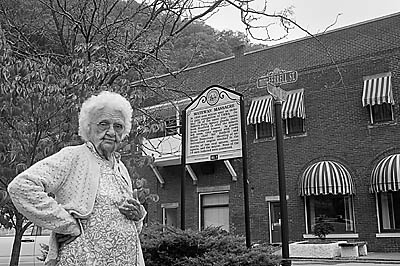
Marie Cooley Robinette, age 94, has lived in the vicinity of Matewan, Mingo County, all of her life. At age 10, she was an eyewitness to the infamous gun battle that took place on May 19, 1920, known today as the Matewan Massacre. Marie is shown here near the site of the incident. Photograph by Michael Keller.
Eyewitness
Marie Robinette of Matewan
By Dallas H. Jude
Marie Cooley Robinette, a lifelong resident of the Matewan area in Mingo County, is quite a lady. At 94 years of age, she is intelligent, enjoys good health, drives her own car, and is a champion cornbread maker. Marie is also thought to be the last surviving eyewitness to the Matewan Massacre of 1920. A daughter and wife of railroad workers, she has also been witness to the difficult struggles of the early railroad workers who built and maintained the Norfolk & Western Railroad as they opened up the southern coalfields. Today, Marie is witness to the effort on the part of the town of Matewan to revitalize its declining economy by creating a thriving tourism industry.
When Marie Cooley, a 10-year-old girl at the time, left her home on the cloudy, dreary afternoon of May 19, 1920, to go to the grocery store for the family’s evening meal, she never dreamed she would find herself in the midst of one of the most infamous gun battles in American history.
The Matewan Massacre occurred as a result of the early conflict between miners and coal operators. In 1920, coal companies in the Matewan area were evicting striking miners from their company-owned homes. The coal operators hired the Bluefield-based Baldwin-Felts detective agency to help with the evictions. On May 19, several Baldwin-Felts detectives evicted six families from their homes at Stone Mountain Coal Company, a short distance from Matewan. After the evictions, the detectives returned to Matewan and planned to catch the 5:00 train to return to Bluefield. Shortly before the train arrived, shooting broke out. Ten people were killed, including seven of the Baldwin-Felts detectives. Marie vividly recalls the events that took place there 84 years ago:
“On my way to the grocery store, I observed that an unusually large number of people were in town that day with numerous small groups talking in low, excited tones. Many of the people were strangers to me, and many of them were carrying cases that I later learned contained firearms.
“As a 10-year-old girl, these things didn’t have much meaning to me. I went into the grocery store, which was owned and operated by C.C. Testerman, who was the mayor of Matewan. Testerman would be one of the 10 people killed in Matewan that day. I had been in this store many times in the past, and I recall Mayor Testerman being a nice, kind, friendly man. After leaving the store, I walked by the old Matewan railroad depot.
“When I got just a few feet past the railroad depot, the shooting began. It seemed as though bullets were flying everywhere. I could hear the bullets whizzing by me. One of the bullets hit the railroad ties just a foot or so in front of me. The shooting lasted quite a while. Many shots were fired initially, with the shooting becoming more sporadic after a few minutes. I still recall how scared I was, and I remember running on home as fast as I could.”
You can read the rest of this article in this issue of Goldenseal, available in bookstores, libraries or direct from Goldenseal.